Sediments/Sedimentology
< Sediments
Sedimentology is the science and study of sediments.
With appropriate conditions, sediment is transformed into rock. These are the sedimentary rocks.
Theoretical sedimentology
Def. a "study of natural sediments and of the processes by which they are formed"[1] is called sedimentology.
Sediments
Def. a "collection of small particles, particularly dirt, that precipitates from a river or other body of water"[2] is called a sediment.
Intraclasts
Def. a "sediment formed by the redeposition of material erodes from an original deposit"[3] is called an intraclast.
Lithification
Def. the "compaction and cementation of sediment into rock"[4] is called lithification.
Def. a "subdivision of any stratigraphic unit that has characteristic lithologic features"[5] is called a lithofacies.
Def. the "formation of sedimentary rock"[6] is called lithogenesis.
Def. "an element that forms silicates or oxides and is concentrated in the minerals of the Earth's crust"[7] is called a lithophile.
Bedrocks
Def. a "solid rock that exists at some depth below the ground surface"[8] is called a bedrock.
"Bedrock is rock "in place", as opposed to material that has been transported from another location by weathering and erosion."[8]
Usage notes
"In mountainous regions, bedrock can be seen at the surface. However, these occurrences are more properly called outcrops."[8]
Regoliths
Def. a "layer of loose rock, dust, sand, and soil, resting on the bedrock, that constitutes the surface layer"[9] is called a regolith.
Saprolites
Def. "a chemically weathered rock "[10] is called a saprolite.
Laterites
Def. a "red hard or gravel-like soil or subsoil [...] that has been leached of soluble minerals leaving insoluble iron and aluminium oxides and hydroxides"[11] is called a laterite.
Drifts
Def. a "mass of matter which has been driven or forced onward together in a body, or thrown together in a heap"[12] is called drift.
The image on the right shows morainic drift on the surface north of the surge glacier Brúarjökull in Iceland.
Tills

Def. "glacial drift consisting of a mixture of clay, sand, pebbles and boulders"[13] is called till, or glacial till.
The image on the right shows glacial till exposed in a road cut with some plants growing on top.
Outwashes
Def. a "sediment (mostly sand and gravel) deposited by water flowing from a melting glacier"[14] is called an outwash.
Erratics
Def. a "rock moved from one location to another"[15] is called an erratic.
Landslides
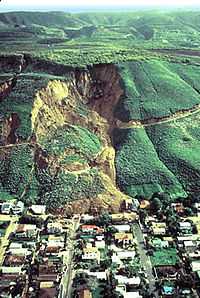
Def. "a movement of surface material down a slope"[16] is called a landslide.
Lahars
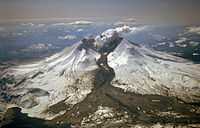
Def. a "volcanic mudflow"[17] is called a lahar.
Part of the Mount St. Helens lahar entered Spirit Lake (lower left corner of the image on the right) but most of the flow went west down the Toutle River, eventually reaching the Cowlitz River, 50 miles (80 kilometers) downstream.
Entrainments
Def. any "of several processes in which a solid or liquid is put into motion by a fluid"[18] is called entrainment.
Def. "of, relating to, or situated or occurring at the surface of a glacier"[19] is called supraglacial.
Def. occurring "or located within a glacier"[20] is called englacial.
Def. formed, "or occurring beneath a glacier or other body of ice"[21] is called subglacial.
Diamictons
Def. "nonsorted, noncalcareous terrigenous deposits composed of sand and/or larger particles dispersed through a muddy matrix"[22] are called diamictons.
Alluviums
Def. "soil, clay, silt or gravel deposited by flowing water, as it slows, in a river bed, delta, estuary or flood plain"[23] is called alluvium.
Loesses
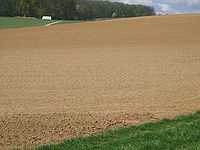
Def. any "sediment, dominated by silt"[24] is called loess.
Def. fine-grained, "silt-size sediment formed by the mechanical erosion of bedrock at the base and sides of a glacier by moving ice"[25] is called rock flour.
"When [rock flour] enters a stream, it turns the stream's color brown, gray, iridescent blue-green, or milky white. [It is also] called Glacier Flour or Glacier Milk."[25]
Soils
Def.
- a "mixture of sand and organic material, used to support plant growth",[26]
- an "unconsolidated mineral or organic material on the immediate surface of the earth that serves as a natural medium for the growth of land plants",[26] and
- an "unconsolidated mineral or organic matter on the surface of the earth that has been subjected to and shows effects of genetic and environmental factors of: climate (including water and temperature effects), and macro- and microorganisms, conditioned by relief, acting on parent material over a period of time"[26]
is called a soil.
"The Port series [shown in the profile on the right] consists of very deep, well-drained, moderately permeable, nearly level and very gently sloping soils on flood plains that are subject to frequent, occasional, or rare flooding. These soils are in western and central Oklahoma. They are in 33 of the 77 counties and make up about 1 million acres."[27]
"These soils formed in calcareous, loamy alluvium and under native grasses. A high volume of organic matter recycled in a grass ecosystem has resulted in good soil structure and tilth. Most areas of the soils are used as cropland. The main cultivated crops are alfalfa, wheat, grain sorghum, and cotton. Some areas are used as pasture or rangeland."[27]
Aeolianites
Def. a "rock formed from dune sand, often calcareous"[28] is called an aeolianite.
Turbidites
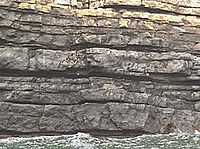
Def. "sea-bottom deposits formed by massive slope failures where rivers have deposited large deltas"[29] are called turbidites.
"Turbidites [shown in the image on the right] are sea-bottom deposits formed by massive slope failures where rivers have deposited large deltas. These slopes fail in response to earthquake shaking or excessive sedimentation load. The temporal correlation of turbidite occurrence for some deltas of the Pacific Northwest suggests that these deposits have been formed by earthquakes."[29]
"Turbidites (interbedded with mudstones/siltstones) from the Ross Sandstone Formation Turbidite system of Namurian age in County Clare, Western Ireland. The sandstone beds were formed in a deep basin by turbidites coming from a delta area."[29]
Marginal marines
The marginal marine sequence on the right has been dated to the Middle Triassic.
Limestones
The middle Triassic layers of alpine limestone in the image on the right were deposited on the bottom of a shallow sea.
Layered sediments
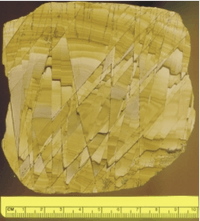
Def. secondary "rings or bands resulting from rhythmic precipitation in a gel, or within a fluid-saturated rock"[30] are called Liesegang rings.
"The ruin marble structure of the Cretaceous/Paleogene fine-grained marly limestone from the Outer Flysch Belt of the Western Carpathians has a non-tectonic origin, according to structural and sedimentological evidence. Distinctive offsets of coloured red-brownish ferric oxyhydroxide bands are not due to displacements along rock-cutting fractures, as they superficially appear to be. Evidences for shear movement along these pseudo-faults were not observed. Band offsets result from different velocities of pervasively diffusing fluids, precipitating ferric oxyhydroxides in corridors bounded by sets of mineralised systematic joints. During rock weathering, calcite-filled joints operated as barriers for lateral fluid diffusion, but enabled longitudinal diffusion along healed joints."[31]
Diameters
Def. a "particle classification system ... based on diameter"[32] is called the Wentworth scale.
Boulders
Def. "[a] particle [or large piece of stone] greater than 256 mm in diameter [that can theoretically be moved if enough force is applied]"[33] is called a boulder.
Cobbles
Def. "[a] particle from 64 to 256 mm in diameter"[34] is called a cobble.
Pebbles
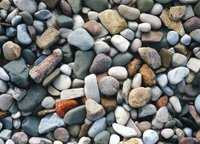
Def.' "[a] particle from 4 to 64 mm in diameter"[35] is called a pebble.
Granules
Def. "[a] particle from 2 to 4 mm in diameter"[36] is called a granule.
Gravels

Def. "[a] particle from 2 to 64 mm in diameter"[37] is called a gravel.
Sands
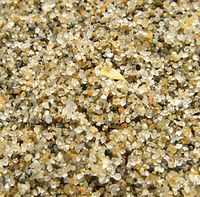
Def. "[a] particle from 62.5 microns to 2 mm in diameter"[38] is called a sand.
Muds
Def. "[a] particle less than 62.5 microns in diameter"[39] is called a mud.
Silts
Def. a "particle from 3.9 to 62.5 microns in diameter"[40] is called silt.
Clays
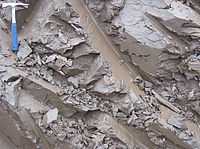
Def. a "particle less than 3.9 microns in diameter"[41] is called clay.
Colloids
Def. "[a] particle less than 1 micron in diameter"[42] is called a colloid.
Technology
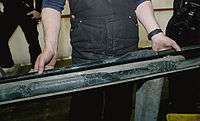
A sediment core sample extracted for the ANtarctic geological DRILLing program known as ANDRILL is shown on the right. Sediment and rock core were extracted from the ocean floor under the Ross Ice Shelf during the 2006-2007 austral summer.
Research
Hypothesis:
- Sedimentology like other sciences begins with common elements such as sediments.
Control groups

The findings demonstrate a statistically systematic change from the status quo or the control group.
“In the design of experiments, treatments [or special properties or characteristics] are applied to [or observed in] experimental units in the treatment group(s).[43] In comparative experiments, members of the complementary group, the control group, receive either no treatment or a standard treatment.[44]"[45]
Proof of concept
Def. a “short and/or incomplete realization of a certain method or idea to demonstrate its feasibility"[46] is called a proof of concept.
Def. evidence that demonstrates that a concept is possible is called proof of concept.
The proof-of-concept structure consists of
- background,
- procedures,
- findings, and
- interpretation.[47]
See also
References
- ↑ SemperBlotto (18 August 2006). "sedimentology, In: Wiktionary". San Francisco, California: Wikimedia Foundation, Inc. Retrieved 2014-11-09.
- ↑ "sediment, In: Wiktionary". San Francisco, California: Wikimedia Foundation, Inc. 29 October 2014. Retrieved 2014-12-05.
- ↑ "intraclast, In: Wiktionary". San Francisco, California: Wikimedia Foundation, Inc. 21 June 2013. Retrieved 2015-02-15.
- ↑ "lithification, In: Wiktionary". San Francisco, California: Wikimedia Foundation, Inc. 17 August 2013. Retrieved 2015-02-19.
- ↑ "lithofacies, In: Wiktionary". San Francisco, California: Wikimedia Foundation, Inc. 27 May 2014. Retrieved 2015-02-19.
- ↑ "lithogenesis, In: Wiktionary". San Francisco, California: Wikimedia Foundation, Inc. 26 May 2014. Retrieved 2015-02-19.
- ↑ "lithophile, In: Wiktionary". San Francisco, California: Wikimedia Foundation, Inc. 2 April 2014. Retrieved 2015-02-19.
- 1 2 3 "bedrock, In: Wiktionary". San Francisco, California: Wikimedia Foundation, Inc. 7 July 2014. Retrieved 2014-12-05.
- ↑ "regolith, In: Wiktionary". San Francisco, California: Wikimedia Foundation, Inc. 25 May 2014. Retrieved 2014-12-05.
- ↑ "Saprolite, In: Wikipedia". San Francisco, California: Wikimedia Foundation, Inc. 12 April 2014. Retrieved 2014-12-05.
- ↑ "laterite, In: Wiktionary". San Francisco, California: Wikimedia Foundation, Inc. 24 May 2014. Retrieved 2014-12-05.
- ↑ "drift, In: Wiktionary". San Francisco, California: Wikimedia Foundation, Inc. 18 October 2014. Retrieved 2014-12-03.
- ↑ "till, In: Wiktionary". San Francisco, California: Wikimedia Foundation, Inc. 17 November 2014. Retrieved 2014-12-04.
- ↑ "outwash, In: Wiktionary". San Francisco, California: Wikimedia Foundation, Inc. 17 April 2014. Retrieved 2014-12-05.
- ↑ "erratic, In: Wiktionary". San Francisco, California: Wikimedia Foundation, Inc. 13 August 2014. Retrieved 2014-12-05.
- ↑ USGS (July 18, 2012). "Earthquake Glossary - landslide". Menlo Park, California USA: USGS. Retrieved 2014-12-02.
- ↑ "lahar, In: Wiktionary". San Francisco, California: Wikimedia Foundation, Inc. 16 December 2014. Retrieved 2015-02-17.
- ↑ "entrainment, In: Wiktionary". San Francisco, California: Wikimedia Foundation, Inc. 7 November 2013. Retrieved 2014-11-22.
- ↑ "supraglacial, In: Wiktionary". San Francisco, California: Wikimedia Foundation, Inc. 26 May 2014. Retrieved 2014-11-22.
- ↑ "englacial, In: Wiktionary". San Francisco, California: Wikimedia Foundation, Inc. 20 April 2011. Retrieved 2014-11-22.
- ↑ "subglacial, In: Wiktionary". San Francisco, California: Wikimedia Foundation, Inc. 1 February 2011. Retrieved 2014-11-22.
- ↑ L. J. G. Schermerhorn (September 1966). "Terminology of Mixed Coarse-Fine Sediments: NOTES". Journal of Sedimentary Petrology 36 (3): 831-5. http://archives.datapages.com/data/sepm/journals/v33-37/data/036/036003/0831.htm. Retrieved 2014-11-08.
- ↑ SemperBlotto (12 August 2005). "alluvium, In: Wiktionary". San Francisco, California: Wikimedia Foundation, Inc. Retrieved 2014-11-10.
- ↑ SemperBlotto (31 March 2006). "loess, In: Wiktionary". San Francisco, California: Wikimedia Foundation, Inc. Retrieved 2014-11-10.
- 1 2 Eleyne Phillips (16 December 2004). "Glossary of Glacier Terminology". Reston, Virginia USA: United States Geological Survey. Retrieved 2014-11-09.
- 1 2 3 "soil, In: Wiktionary". San Francisco, California: Wikimedia Foundation, Inc. 25 November 2014. Retrieved 2014-12-05.
- 1 2 Natural Resources Conservation Service (05 December 2014). "Port -- Oklahoma State Soil". Washington, DC USA: U. S. Department of Agriculture. Retrieved 2014-12-05.
- ↑ "aeolianite, In: Wiktionary". San Francisco, California: Wikimedia Foundation, Inc. 28 May 2014. Retrieved 2014-12-06.
- 1 2 3 USGSTurbidites (July 24, 2012). "Earthquake Glossary - turbidites". Menlo Park, California USA: USGS. Retrieved 2014-12-02.
- ↑ "Liesegang rings, In: Wiktionary". San Francisco, California: Wikimedia Foundation, Inc. 19 June 2013. Retrieved 2015-02-21.
- ↑ František Marko, Daniel Pivko and Vratislav Hurai (2003). "Ruin marble: a record of fracture-controlled fluid flow and precipitation". Geological Quarterly 47 (3): 241-52. https://gq.pgi.gov.pl/article/download/7313/5963. Retrieved 2015-02-21.
- ↑ "Wentworth scale, In: Wiktionary". San Francisco, California: Wikimedia Foundation, Inc. September 13, 2012. Retrieved 2012-10-23.
- ↑ "boulder, In: Wiktionary". San Francisco, California: Wikimedia Foundation, Inc. September 21, 2012. Retrieved 2012-10-23.
- ↑ "cobble, In: Wiktionary". San Francisco, California: Wikimedia Foundation, Inc. September 1, 2012. Retrieved 2012-10-23.
- ↑ "pebble, In: Wiktionary". San Francisco, California: Wikimedia Foundation, Inc. October 16, 2012. Retrieved 2012-10-23.
- ↑ "granule, In: Wiktionary". San Francisco, California: Wikimedia Foundation, Inc. October 16, 2012. Retrieved 2012-10-23.
- ↑ "gravel, In: Wiktionary". San Francisco, California: Wikimedia Foundation, Inc. October 16, 2012. Retrieved 2012-10-23.
- ↑ "sand, In: Wiktionary". San Francisco, California: Wikimedia Foundation, Inc. October 23, 2012. Retrieved 2012-10-23.
- ↑ "mud, In: Wiktionary". San Francisco, California: Wikimedia Foundation, Inc. October 23, 2012. Retrieved 2012-10-23.
- ↑ Metaknowledge (31 March 2006). "silt, In: Wiktionary". San Francisco, California: Wikimedia Foundation, Inc. Retrieved 2014-11-10.
- ↑ Metaknowledge (17 March 2012). "clay, In: Wiktionary". San Francisco, California: Wikimedia Foundation, Inc. Retrieved 2014-11-10.
- ↑ "colloid, In: Wiktionary". San Francisco, California: Wikimedia Foundation, Inc. September 8, 2012. Retrieved 2012-10-23.
- ↑ Klaus Hinkelmann, Oscar Kempthorne (2008). Design and Analysis of Experiments, Volume I: Introduction to Experimental Design (2nd ed.). Wiley. ISBN 978-0-471-72756-9. http://books.google.com/?id=T3wWj2kVYZgC&printsec=frontcover.
- ↑ R. A. Bailey (2008). Design of comparative experiments. Cambridge University Press. ISBN 978-0-521-68357-9. http://www.cambridge.org/uk/catalogue/catalogue.asp?isbn=9780521683579.
- ↑ "Treatment and control groups, In: Wikipedia". San Francisco, California: Wikimedia Foundation, Inc. May 18, 2012. Retrieved 2012-05-31.
- ↑ "proof of concept, In: Wiktionary". San Francisco, California: Wikimedia Foundation, Inc. November 10, 2012. Retrieved 2013-01-13.
- ↑ Ginger Lehrman and Ian B Hogue, Sarah Palmer, Cheryl Jennings, Celsa A Spina, Ann Wiegand, Alan L Landay, Robert W Coombs, Douglas D Richman, John W Mellors, John M Coffin, Ronald J Bosch, David M Margolis (August 13, 2005). "Depletion of latent HIV-1 infection in vivo: a proof-of-concept study". Lancet 366 (9485): 549-55. doi:10.1016/S0140-6736(05)67098-5. http://www.ncbi.nlm.nih.gov/pmc/articles/PMC1894952/. Retrieved 2012-05-09.
External links
![]() This is a research project at http://en.wikiversity.org
This is a research project at http://en.wikiversity.org
| |
Development status: this resource is experimental in nature. |
| |
Educational level: this is a research resource. |
| |
Resource type: this resource is an article. |
| |
Resource type: this resource contains a lecture or lecture notes. |
| |
Action required: please create Category:Sediments/Lectures and add it to Category:Lectures. |
| |
Subject classification: this is a Geology resource. |